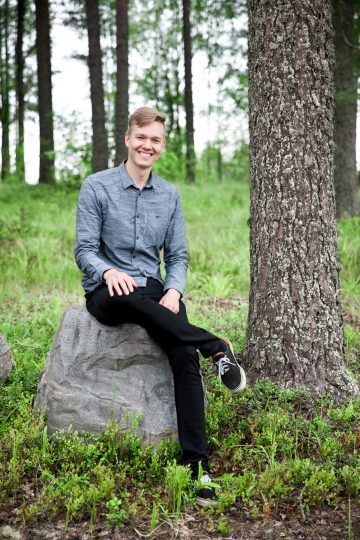From wood waste into wood art

Miikka Kotilainen
Founder, CEO, Creative Director
Puuartisti Oy / Woodartist Ltd.
Finland
miikka@puuartisti.fi

Mari Kotilainen
Freelance Copywriter
A small Finnish woodworking company on a mission to make wood worth gold
**
When I founded our woodworking company Puuartisti (Woodartist Ltd.) 8 years ago, my dream was to design and manufacture only unique pieces of carefully crafted furniture. Ultra high quality and no compromises when it comes to details. If only I could find enough clients to make my own living, I would be happy – not an easy task in the field of woodworking, claimed as one of the “sunset industries” where most struggle with profitability.
Obviously I knew the grim facts: finding the right kind of customers would be challenging, because many Finnish people choose mass-produced throwaway furniture and don’t even consider investing in higher-quality items. Many don’t really seem to value wood, either: we live surrounded by vast forests, so trees are just mass: they grow, are sawn, processed and burnt for energy.
So there I was, a young man in my 20’s – with not much else than a dream and a small workshop. First I made a few dining tables, until I managed to land the most significant deal so far: the whole interior of a local restaurant. We were looking for extremely rustic material for the wall panels and tabletops, and I managed to find almost 100 year old reclaimed wood that had been dismantled from an old log drivers’ cabin. The material goes back to the days when logs were transported via waterways, and the workers needed places to rest along the rivers: the planks used to serve as the walls and floors of one of these cottages, and they were weather-worn and covered with all sorts of carvings by these loggers – even bullet holes.
That really struck me.
The wood had “lived” through intriguing times and such naturally worn material could not be fabricated – the beauty of it was irreplicable. I realized what our mission was: that I didn’t want any trees to be felled for our products; that I wanted to show the beauty of unique reclaimed and waste wood materials in ultra-finished and carefully designed wood installations – the types that people couldn’t even imagine. Pieces of modern furniture that would always feature something new. And I started digging.
We found trees that had been felled in a park in our neighboring city of Joensuu. Piles of hard-to-find trees such as bigger rowans or poplars, both species with particularly beautiful grain patterns when used in furniture. All going to the energy plant, and the local people were outraged. We wrote down stories about the trees and their past, and shared them with our followers on social media.
When the years passed, our projects grew. In 2018 we landed a project that would truly showcase our mission. We got the chance to design and manufacture the sauna interior to the headquarters of the multi-billion video gaming company Supercell. I became pickier in terms of raw materials, so I dug deeper. The material that I chose to use in that specific sauna is something that is never used in the woodworking industry: we collected 100 storm-felled spruce trees from which we would use the leftovers, the roots. The natural curve in the roots would form the actual curve of the sauna bench, so the person in the sauna would sit “on the root”.
We documented the spruce root project from the start to finish. Our social media audience had grown quite a lot and yet again we were astonished by how interested people were about a project they would probably never see with their own eyes, and how inspired they were about the fact that such beautiful design could be made from raw material that was considered pure mass for energy production.
The root sauna gained a lot of nation-wide attention and media coverage, and we have continued our experiments. We found tree trunks that had sat underwater for dozens of years and made a sauna interior out of them. At the moment we are making a table from pieces of wood that have been excavated from peatlands. The wood has sat there in the wetland for centuries and now end up in a dining table for the next hundreds of years.
But does it matter that a small company like us has big aspirations to increase the valuation of wood if we only make 1-3 projects in a year? Obviously the problem is that our work cannot be scaled. The number of manhours in each of our latest projects is calculated in thousands, so we can’t really help with the overproduction of meaningless furniture on a larger scale.
What we can do is communicate. We document all projects thoroughly and publish them in social media, and constantly hear the “wow, I wish I had the chance to buy something like that – I don’t, but I’ll find the old coffee table that my grandad bought and have it repaired, since it’s solid wood and can actually be repaired.”
Now I have succeeded in making my own living and employing a few others, as well, but what really measures our success is whether we actually can produce value to both our clients and the wider audience. To inspire people to value things that last. Since we need our trees growing.
Expert article 3326
>Back to Baltic Rim Economies 5/2022
To receive the Baltic Rim Economies review free of charge, you may register to the mailing list.
The review is published 4-6 times a year.
